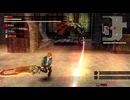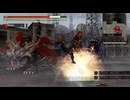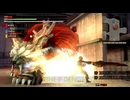
Shift's Gods Eater Burst suffered from two main issues in gaining exposure to RPGamers. Firstly, a lack of marketing support from Namco Bandai, or its North American subsidiary D3 Publisher, meant when I purchased the game on release day the store's staff had to go into the back of the store with no idea the game actually existed. Sadly, this seems to be a more common occurence in JRPGs recently even when the support is there. Secondly, a frequent and usually immediate dismissal that the game was simply a Monster Hunter clone. However, Gods Eater Burst deserves far more credit than it is usually given, and is worthy of being taken on its own merits without influencing thoughts of Capcom's series.
While slipping under the radar in the west, God Eater has been a success in Japan, selling over a half a million copies. Gods Eater Burst is an enhanced edition of the original game, featuring an additional storyline following on from that of the original game, plus many extra weapons, clothing etc. The storyline and setting is one of the areas where the game really stands apart from Monster Hunter focus entriely on crafting and beating up said monsters. It's not a perfect story, relying a bit too much on familiar anime tropes, but there's stuff to like for fans of either and the post-apocalyptic setting is fascinating. Around sixty years in the future, mankind is battling against aggressive creatures called Aragami that have rained destruction on Earth since their mysterious appearance. Fenrir, an anti-Aragami organisation, employs Gods Eaters such as the player to battle against the Aragami wielding rather large biological weapons called God Arcs, made from the special Oracle Cells that make up the Aragami.
  
Combat is where the obvious parallels to Monster Hunter come in, with the player and up to three allies embarking on missions with the objective of defeating one or more specific Aragami. Contrary to Monster Hunter's style of sending the player out alone if unable to find online party members, Gods Eater Burst is at least kind enough to provide AI companions, each of whom provide his or her own bonuses and have a particular style of fighting. These styles matches their personalities shown if talked to when wandering the Fenrir complex. The combat is highly enjoyable, requiring a good combination of skill and preparation, with the minor annoyance of needing to utilise "The Claw" to fully work the camera, fortunately something that playing the game on the Vita can avoid.
One of the more hidden but interesting features of game allows players can create their own bullets for use in the game. Once used to the systems, creating new and interesting damage effects through the immense number of options available is highly addictive. Particular highlights that can be created include a homing mortar that explodes into a large fireball, a bullet that latches on before exploding into multiple swirling lasers, or even a recovery bullet that can heal all allies close to the player.
 
A special mention should also be reserved for the soundtrack. Composed by Go Shiina, previously known to RPGamers thanks to his Tales of Legendia score, the soundtrack blends multiple styles and themes. The merging of styles intertwines almost perfectly with the game's setting and really brings the game to life thanks to skilled performance, mixing, and orchestration, even when put through the PSP's limited speakers. It also features a few catchy vocal tracks, including two excellent theme songs provided by Tibetan-Chinese singer Alan.
Gods Eater Burst may have not have a huge fanbase purely due to a lack of exposure, but a large percentage of those who discovered the game found many reasons to become hooked. Whether or not God Eater 2, being released in Japan on PSP and Vita this year, makes it to the west remains to be seen, but there are certainly those who hope it will, myself included.
— Alex Fuller
« Back | Next - Summon Night: Twin Age »
|









